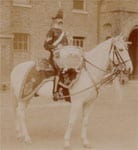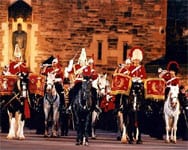About Gypsies and Drums
This Breed ‘s development has been met with a lot of controversy, mainly over the correct “name” for the breed. This breed has numerous registry associations and it is being developed basically online, which has caused a lot of confusion.
Gypsy Vanners
 The “Gypsy Horse”, known in America as the Gypsy Vanner, was bred by Gypsy Travelers to pull their ornate caravans and carts. They come in a variety of colors from pintos to solid blacks as well as the rarer buckskin and paliminos. Long flowing manes and tails, and of course, an abundant amount of leg feathering is highly desirable. The Gypsy Horse’s intelligence, stamina, hardiness and sensibility of these horses are unsurpassed by any other breed today! (This type of horse may also be called Gypsy Cob, Irish Cob and Romany Horse, etc… Technically to “be” a “Vanner”, they must be registered with the Gypsy Vanner Horse Society)
The “Gypsy Horse”, known in America as the Gypsy Vanner, was bred by Gypsy Travelers to pull their ornate caravans and carts. They come in a variety of colors from pintos to solid blacks as well as the rarer buckskin and paliminos. Long flowing manes and tails, and of course, an abundant amount of leg feathering is highly desirable. The Gypsy Horse’s intelligence, stamina, hardiness and sensibility of these horses are unsurpassed by any other breed today! (This type of horse may also be called Gypsy Cob, Irish Cob and Romany Horse, etc… Technically to “be” a “Vanner”, they must be registered with the Gypsy Vanner Horse Society)
This remarkable horse was involved in just about every aspect of the Gypsy Traveler’s life! During the day the Gypsy Horse pulled the caravan for miles, entrusted with the families’ worldly possessions. Once camp was established they took watch over the Gypsy children, taking them on small rides and allowing them to climb and crawl over them! The horses were so valuable to the travelers, that in some areas, these horses took the form of currency!
No other established breed will compare to the history that the Gypsy Horses hold. What other breed of horse do you know of, that will fetch tens of thousands of dollars, with no papers and no guarantee? They do just that in the UK and Ireland. These horses are still rare in the US, but are quickly gaining popularity among horse enthusiasts, excelling in just about every discipline put to the test.
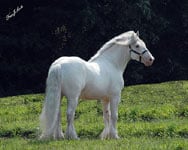
Characteristics: Well of course the first distinguishing difference between a “normal” horse and a Gypsy Horse would be the leg feather. The feather should abundant and thick. Then you will notice, if the horse is not clipped, that it will most likely have a mustache that curls up along the horse’s lips and an abundance of jaw hair, often referred to as a beard, will also be much longer than that of other breeds. Some may be so long that the beard hair comes down to the horse’s bottom lip! In general a Gypsy Horse should have a thick mane and tail and heavy long hair (feather) starting at the knee that covers the entire front of the hoof, around the back and up the leg to the back of the knee or hock. They also have a fairly short back in proportion to it’s overall body, a neck that matches their build and in general give the appearance of a “miniature” draft horse. Their temperaments are even and they have very willing personalities.
View our Registered Gypsy Vanner Stallions Cobalt and Slainte. (Cobalt has won 6 Championship titles and Slainte 11 plus was the 2005-2006 DAC company representative, seen in their product booths, on their 2005 catalog and in their 2006 DAC Oil description, as well as on their website.)
What’s the difference?
The difference between Gypsy Cobs and Gypsy Vanners is not height…They are simply different registries (the GCDHA and GCSA register “Cobs”, The GVHS registers “Vanners”) All have different standards and different registration guidelines.
The Gypsy Vanner Society calls them “Gypsy Vanner”. The name came from the horses being bred by the “Gypsy people”, and the horse’s job was to pull a “caravan”. The registration process includes several requirements each different depending on the sex, age and lineage available on each horse. Videos are required for all stallions and of course pictures are required on all horses regardless. Horses must pass inspection by a board of five individuals. The Gypsy Vanner Horse Society does not register crossbred Vanners and frowns upon crossbreeding any registered Vanner.
* There is currently a certification program in place for registered Vanners, however it is not sponsored or sanctioned by the Gypsy Vanner Horse Society. It is a private program owned and run by the founder of the GVHS. It is basically a “buy-in” marketing program, in which the owner of the “Certified Vanner Program”, solely, labels a horse worthy of participating. The participant then pays yearly dues to continue to participate. The owner of the certified horse has stated that 99% of the Gypsy Vanners currently registered would qualify for his certification program. Old Mill Farm, has decided not to participate.
*NOTE* Not all “Gypsy Horses” will automatically be registered in either association. There have been horses that were turned down by either one or both registries. If you are purchasing an unregistered horse, please do your research, and even ask that the horse be registered prior to the sale.
Confused as to what makes a Drum Horse or a Gypsy Cob? Read the Breed Standards.
Click below to see more photos and learn more interesting facts about the breed and the people involved!
Drum Horses
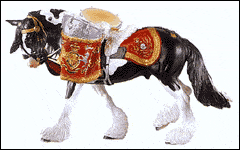 Actually named after a “job” performed by the horse, The Drum Horse is an indispensable part of the Band of the Life Guards. These horses carried two large solid silver kettle Drums, plus a fully outfitted rider, through crowds of thousands, during the Queen’s processions! The extraordinary part was that these horses were controlled entirely by reins attached to the rider’s stirrups as they had to use their hands to beat on the drums. (See picture below) The Calvary Drum Horse is one of the most popular and recognizable members of the regiment. Nearly always “Pinto” or “Sabino”in color in the present day, it is still common to see solids.
Actually named after a “job” performed by the horse, The Drum Horse is an indispensable part of the Band of the Life Guards. These horses carried two large solid silver kettle Drums, plus a fully outfitted rider, through crowds of thousands, during the Queen’s processions! The extraordinary part was that these horses were controlled entirely by reins attached to the rider’s stirrups as they had to use their hands to beat on the drums. (See picture below) The Calvary Drum Horse is one of the most popular and recognizable members of the regiment. Nearly always “Pinto” or “Sabino”in color in the present day, it is still common to see solids.
Drum Horses must be strong and steady enough to carry the stout kettle drums during ceremonies. It takes a very special horse to carry such a prominent role in the Queen’s Household Cavalry.
Actual performing, Drum Horses were always geldings, however they now have a mare in use! They were never sold, however retired after their services were over.
Drum Horses of the past. (Various Military Branches are being represented)
Drum Horse of the Present
*We would like to thank Anthony Hope for providing the pictures of the Drum Horses above. He has an extensive collection of Drum Horse photos. To view more in his collection, please go to http://community.webshots.com/user/scarletlancer165 or search for scarletlancer165.
Drum Horses are taking on a new meaning in America, as we have no Queen’s processions to attend! When crossed with another feathered breed, for example a Clydesdale, Shire or in most cases a larger Gypsy Cob, the offspring will most likely be of Drum type and be eligible for registration with the American Drum Horse Association (ADHA). (Please see www.drumhorseassociation.com for the exact standards and registration requirements) Drum horses are perfectly suited for taller heavier riders that need a horse with more substance and height, but still want a calm, level headed riding horse. Because of their quiet nature, some Drum Horses may even be suited for pleasure driving. To view in person, this magical creature of history, will render you speechless, they are unlike any other breed in the world! 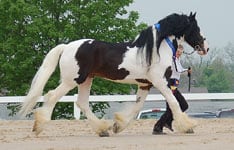
View our Registered Drum Horse Stallion Chew Mill Guinness (Son of Galway Warrior, grandson of the world famous Shire, Edingale Mascot)
Drum Horse Registry
The American Drum Horse Association (ADHA) Formed Jan 2006, to date, the ADHA is the only registry dedicated to the sole registration and promotion of the Drum Horse here in America. Vist them at www.drumhorseassociation.com
What is the difference between the Gypsy Cob / Gypsy Vanner and the Drum Horse? Breeding and registration requirements! The Drum Horse must be a combination of Shire, Clydesdale and Gypsy Horse. Gypsy Cobs and Gypsy Vanners are full-blooded and have been in existance for a debatable, 50 years or more.
We can not stress enough, A Drum Horse is NOT a large Gypsy Cob or Vanner. A Gypsy Cob/Vanner is not limited to size and a Drum Horse that is under 16 hands is NOT re-classified into the Gypsy Cob category. The term “gypsy drum” is incorrect…they are one or the other.
“Feather” Facts …
The feather topic, seems to be a controversial one! Here are some facts regarding feather.
There are basically two types of feather, the straight silky type or the course (sometimes curly) type. The straight silky type is desired by most breeders, of course subject to opinion, however it requires a lot more maintenance. Because the hair strand is usually thinner, it will usually not look as full as the course feather will, it also will burn off a lot quicker.
The course type, it is hardier and looks fuller. But because the hair strand is thicker, it holds more water, and does not dry as quickly, which means the feather may need to be dried after baths or turnout, in order for the skin underneath the feather to stay healthy. (Continous moist skin invites fungus and bacteria to breed)
Burned feather simply means that the feather was subject to environmental changes. Wet to dry conditions over time will dry out the hair causing it to break off. Mud left on to dry will also dry out the the hair causing breakage. It is also important to note feather is also something that develops with age.
Buying a Gypsy Horse
Depending of course on quality, age, sex, breeding and training, you should look at spending anywhere from 15,000.00 and up on a young Gypsy Horse. Drum Horses may start a little lower in price, however still seem to average around 10,000.00. Be realistic in what you are planning to spend and do your research on all breeders. “You get what you pay for” in most instances.
*Note on Lineage/Genetics. A majority of these horses do not have known lineage. Those that are being marketed with generations of pedigree should be researched carefully. Many of the horses that are coming over to the US with claimed parentage, are being tested and are indeed not who they were thought to be out of. Do your research, and contact registries to see what DNA is available on the horse that you have purchased or are importing. Remember, that because DNA is required by all US registries, even if you think you know the lineage of your horse, if you can’t prove it by DNA testing, some registries are noting that parentage is not proven on the horse’s official registration papers.
Questions? See our Frequently Asked Questions
Like to see a Gypsy or Drum Horse in person. We welcome visitors by appointment. Please contact us to arrange a visit. No Sunday visits, Please.
